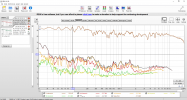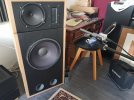I want to find out how much has THX guides been affecting the users.
For myself, I listened critically over the course of a few weeks, comparing XO frequency and the resulting effect on SQ. I have Mains capable down to 25Hz, but also enjoy Organ and Electronic Music which requires deeper extension... thus the Subs.
Originally, I wanted to cross as low as possible to take advantage of the SQ of my Mains. A little experimentation, and I found offloading the Bass at 80 resulted in more clarity in the Mids and Highs. To me, this was most notable with Cymbals having a cleaner attack, or more detailed sizzle from riding on the high hat. I could hear it in Female Vocals, too, Soprano Sax, etc.
It was subtle, and I took care to only do my listening in short sessions as to avoid fatigue (not listening fatigue, but like tasting wine, you start to lose your palette after several different tastes

). For me, I didn't really notice any benefit from crossing higher still, so I stuck with 80 for my Mains.


